ZY3-02 Laser Altimeter Footprint Geolocation Prediction
Abstract
:1. Introduction
2. Basic Information
2.1. Laser Altimetry
2.2. ZY3-02 Laser Altimeter
3. Methodology
3.1. Principle
3.2. Workflow
4. Experiments and Analysis
4.1. Theoretical Error Analysis
- (1)
- The laser pointing prediction applies a terrain-matching method; the computation time is greatly reduced by the pyramid layer-by-layer calculation strategy, and the prediction precision of this method is relatively higher, but the prediction accuracy of laser pointing is limited by the referenced data accuracy. At present, the 30-m grid DEM is used to carry out the laser prediction pointing calculation; when the bottom pyramid traverse grid size is set to two seconds of arc, the resultant ground positioning error is about 5 m. Taking the maximum value of the two error sources, the laser pointing prediction error introduced in both the along- and cross-track directions is about 35 m.
- (2)
- The orbit prediction based on empirical acceleration estimation requires the high-precision historical orbit data before the satellite passes the site. The accuracy of orbit determination can reach better than 20 cm by using the original real-time GPS data. On this basis, the empirical acceleration estimation method is adopted to predict the orbit, and good precision can theoretically be achieved. Before the on-orbit test, the predicted orbit is compared with the high-precision orbit several times, and the maximum error of the orbit prediction is about 150 m in the along-track direction and 20 m in the cross-track direction.
- (3)
- As the ZY3-02 satellite adopts the large platform, to ensure the observation system is vertical to the ground, the momentum wheel is adjusting in real-time by the satellite attitude system; its three-axis design attitude stability is better than 5 × 10−4 °/s (3σ). Taking the fixed frequency of the platform along with processing into consideration, the accuracy of the attitude prediction method based on frequency domain analysis is better than 50 m in the along-track direction and 25 m in the cross-track direction.
- (4)
- The errors caused by atmospheric delay and tide are mainly reflected in the ranging errors, and they have little effect on the horizontal prediction accuracy. Incorporating errors that may be introduced by other factors, the error is about 10 m.
4.2. Relative Accuracy Verification with Precise Post-Processed Data
4.3. Absolute Accuracy Verification with GCPs
5. Conclusions
- The prediction model built in this paper works fairly well at predicting the distribution geolocation of ground laser detector arrays for space-borne laser altimeter on-orbit geometry calibration, and the horizontal offset error is less than 150 m (prediction accuracy) in the final comprehensive prediction.
- Through quantitative analysis of error items, the laser pointing prediction leads to ground geolocation error of about 70 m, which can be eliminated by post-processing of calibration and reaches about 3 m, less than 150 m of orbit prediction error, and less than 30 m of attitude prediction error.
Acknowledgments
Author Contributions
Conflicts of Interest
References
- Jarihani, A.A.; Callow, J.N.; Mcvicar, T.R.; Niel, T.G.V.; Larsen, J.R. Satellite-derived Digital Elevation Model (DEM) selection, preparation and correction for hydrodynamic modelling in large, low-gradient and data-sparse catchments. J. Hydrol. 2015, 524, 489–506. [Google Scholar] [CrossRef]
- Tang, X.M.; Zhou, P.; Zhang, G.; Wang, X.; Jiang, Y.H.; Guo, L.; Liu, S.H. Verification of ZY-3 Satellite Imagery Geometric Accuracy Without Ground Control Points. IEEE Geosci. Remote Sens. Lett. 2015, 12, 2100–2104. [Google Scholar] [CrossRef]
- Jeong, J.; Yang, C.; Kim, T. Geo-Positioning Accuracy Using Multiple-Satellite Images: IKONOS, QuickBird, and KOMPSAT-2 Stereo Images. Remote Sens. 2015, 7, 4549–4564. [Google Scholar] [CrossRef]
- Li, G.Y.; Tang, X.M.; Gao, X.M.; Zhang, C.Y.; Li, T. Improve the ZY-3 Height Accuracy Using Icesat/glas Laser Altimeter Data. Int. Arch. Photogram. Remote Sens. Spat. Inf. Sci. 2016, 41, 37–42. [Google Scholar] [CrossRef]
- Nasir, S.; Iqbal, I.A.; Ali, Z.; Shahzas, A. Accuracy assessment of digital elevation model generated from pleiades tri stereo-pair. In Proceedings of the International Conference on Recent Advances in Space Technologies, Istanbul, Turkey, 16–19 June 2015; pp. 193–197. [Google Scholar] [CrossRef]
- Wang, R.X.; Hu, S.; Wang, J.R. Photogrammetry of Mapping Satellite-1 without Ground Control Points. Acta Geod. Cartogr. Sin. 2013, 42, 1–5. [Google Scholar]
- Wang, R.X.; Wang, J.R.; Zhao, F.; Liu, W. Dynamic Calibrating of Three-Line-Array CCD Camera in Satellite Photogrammetry Using Ground Control Point. J. Earth Sci. Environ. 2006, 28, 1–5. [Google Scholar]
- Tong, X.H.; Ye, Z.; Xu, Y.S.; Tang, X.M.; Liu, S.J.; Li, L.Y.; Xie, H.; Wang, F.X.; Li, T.P.; Hong, Z.H. Framework of Jitter Detection and Compensation for High Resolution Satellites. Remote Sens. 2014, 6, 3944–3964. [Google Scholar] [CrossRef]
- Wang, M.; Yang, B.; Hu, F.; Zang, X. On-Orbit Geometric Calibration Model and Its Applications for High-Resolution Optical Satellite Imagery. Remote Sens. 2014, 6, 4391–4408. [Google Scholar] [CrossRef]
- Kurtz, N.T.; Markus, T.; Cavalieri, D.J.; Krabill, W.; Sonntag, J.G.; Miller, J. Comparison of ICESat Data with Airborne Laser Altimeter Measurements Over Arctic Sea Ice. IEEE Trans. Geosci. Remote 2008, 46, 1913–1924. [Google Scholar] [CrossRef]
- Magruder, L.; Webb, C.E.; Urban, T.; Silverberg, E.C.; Schutz, B.S. ICESat Altimetry Data Product Verification at White Sands Space Harbor. IEEE Trans. Geosci. Remote 2007, 45, 147–155. [Google Scholar] [CrossRef]
- Fricker, H.A.; Borsa, A.; Carabajal, C.C.; Quinn, K.; Bills, B.; Minster, B. Reduction of ICESat Systematic Geolocation Errors and the Impact at the salar de Uyuni, Bolivia. Geophys. Res. Lett. 2005, 32, L21S06. [Google Scholar] [CrossRef]
- Luthcke, S.B.; Rowlands, D.D.; Williams, T.A.; Sirot, M. Reduction of ICESat systematic geolocation errors and the impact on ice sheet elevation change detection. Geophys. Res. Lett. 2005, 32, 312–321. [Google Scholar] [CrossRef]
- Luthcke, S.B.; Rowlands, D.D.; Mccarthy, J.J.; Pavlis, D.E.; Stoneking, E. Spaceborne Laser-Altimeter-Pointing Bias Calibration from Range Residual Analysis. J. Spacecraft Rockets 2012, 37, 374–384. [Google Scholar] [CrossRef]
- Schutz, B.E. GLAS Altimeter Post-Launch Calibration/Validation Plan. Available online: http://www.csr.utexas.edu/glas/pdf/plan/validation_plan_v1_oct2001.pdf (accessed on 1 July 2017).
- Abshire, J.B.; Sun, X.; Riris, H.; Sirota, M.; Palm, S.; Ketchum, E.A. Geoscience laser altimeter system (GLAS) for the ICESat mission-pre-launch performance. In Proceedings of the Conference on Lasers and Electro-Optics (CLEO ‘03), Baltimore, MD, USA, 6 June 2003; p. 3. [Google Scholar] [CrossRef]
- Magruder, L.; Ricklefs, R.L.; Silverberg, E.C.; Horstman, M.F.; Suleman, M.A.; Schutz, B.E. ICESat Geolocation Validation Using Airborne Photography. IEEE Trans. Geosci. Remote 2010, 48, 2758–2766. [Google Scholar] [CrossRef]
- Magruder, L.A. Pointing Angle and Timing Verification of the Geoscience Laser Altimeter Using a Ground-Based Detection System; University Texas: Austin, TX, USA, 2001; pp. 27–38. ISBN 9780493506920. [Google Scholar]
- Filin, S. Calibration of spaceborne laser Altimeters—An algorithm and the site selection problem. IEEE Trans. Geosci. Remote Sens. 2006, 44, 1484–1492. [Google Scholar] [CrossRef]
- Li, D.R. China’s first civilian three-line-array stereo mapping satellite: ZY-3. Acta Geod. Cartogr. Sin. 2012, 41, 317–322. [Google Scholar]
- Tang, X.M.; Zhang, G.; Zhu, X.Y.; Pan, H.B.; Jiang, Y.H.; Zhou, P.; Wang, X. Triple linear-array image geometry model of ZiYuan-3 surveying satellite and its validation. Int. J. Image Data Fusion 2013, 4, 33–51. [Google Scholar] [CrossRef]
- Magruder, L.A.; Schutz, B.E.; Silverberg, E.C. Laser pointing angle and time of measurement verification of the ICESat laser altimeter using a ground-based electro-optical detection system. J. Geod. 2003, 77, 148–154. [Google Scholar] [CrossRef]
- Wang, F.H.; Gong, X.W.; Sang, J.Z.; Zhang, X.H. A Novel Method for Precise Onboard Real-Time Orbit Determination with a Standalone GPS Receiver. Sensors 2015, 15, 30403–30418. [Google Scholar] [CrossRef] [PubMed]
- Zhao, C.M.; Tang, X.M. Precise Orbit Determination for the ZY-3 Satellite Mission Using GPS Receiver. J. Astronaut. 2013, 34, 1202–1206. [Google Scholar] [CrossRef]
- Xie, J.F.; Wang, X. A robust autonomous star identification algorithm for ZY3 satellite. In Proceedings of the 1st International Conference on Agro-Geoinformatics, Shanghai, China, 2–4 August 2012; pp. 1–4. [Google Scholar] [CrossRef]
- Schutz, B.E.; Zwally, H.J.; Shuman, C.A.; Hancock, D. Overview of the ICESat Mission. Geophy. Res. Lett. 2005, 32, 97–116. [Google Scholar] [CrossRef]
- Zwally, H.J.; Schutz, B.; Abdalati, W.; Abshire, I.; Bently, C.; Brenner, A.; Bufton, I.; Dezio, I.; Hancock, D.; Harding, D.; et al. ICESat’s laser measurements of polar ice, atmosphere, ocean, and land. J. Geod. 2003, 34, 405–445. [Google Scholar] [CrossRef]
- Smith, D.E.; Zuber, M.T.; Frey, H.V.; Garvin, J.B.; Head, J.W.; Muhleman, D.O.; Pettengill, G.H.; Phillips, R.J.; Solomon, S.C.; Zwally, H.J.; et al. Mars Orbiter Laser Altimeter: Experiment summary after the first year of global mapping of Mars. J. Geophy. Res. 2001, 106, 23689–23722. [Google Scholar] [CrossRef]
- Rd, H.J.; Hiesinger, H.; Ivanov, M.A.; Kreslavsky, M.A.; Pratt, S.; Thomson, B.I. Possible ancient oceans on Mars: Evidence from Mars Orbiter Laser Altimeter data. Science 1999, 286, 2134–2137. [Google Scholar] [CrossRef]
- Bhandari, N. Chandrayaan-1: Science goals. J. Earth Syst. Sci. 2005, 114, 701–709. [Google Scholar] [CrossRef]
- Cole, T.D. Flight characterization of the NEAR Laser Rangefinder. In Proceedings of the Laser Radar Technology and Applications V, Orlando, FL, USA, 24–26 April 2000; pp. 131–142. [Google Scholar] [CrossRef]
- Smith, D.E.; Zuber, M.T.; Jackson, G.B.; Cavanaugh, J.F.; Neumann, G.A.; Riris, H.; Sun, X.L.; Zellar, R.S.; Coltharp, C.; Connelly, J.; et al. The Lunar Orbiter Laser Altimeter Investigation on the Lunar Reconnaissance Orbiter Mission. Space Sci. Rev. 2010, 150, 209–241. [Google Scholar] [CrossRef]
- Deng, J.Q.; Yang, Y. ZY-3-02 Camera Achieved Higher Stereo Imaging Accuracy. Aerosp. Chin. 2016, 17, 62–63. [Google Scholar]
- Jiang, Y.H.; Zhang, G.; Tang, X.M.; Zhu, X.Y.; Qin, Q.; Li, D.R.; Fu, X.K. High Accuracy Geometric Calibration of ZY-3 Three-line Image. Acta Geod. Cartogr. Sin. 2013, 42, 523–529. [Google Scholar]
- Niell, A.E. Global mapping functions for the atmospheric delay at radio wavelengths. J. Geophy. Res. 1996, 101, 3227–3246. [Google Scholar] [CrossRef]
- Tang, X.M.; Li, G.Y.; Gao, X.M.; Chen, J.Y. The rigorous geometric model of satellite laser altimeter and preliminarily accuracy validation. Acta Geod. Cartogr. Sin. 2016, 45, 1182–1191. [Google Scholar] [CrossRef]
- Wang, W.B.; Liu, R.F. A New Method of Orbit Prediction for LEO Satellites Using Empirical Accelerations. Chin. J. Space Sci. 2015, 35, 715–720. [Google Scholar] [CrossRef]
- Tang, X.M.; Xie, J.F.; Wang, X.; Jiang, W.S. High-Precision Attitude Post-Processing and Initial Verification for the ZY-3 Satellite. Remote Sens. 2015, 7, 111–134. [Google Scholar] [CrossRef]
- Rosenqvist, A.; Shimada, M.; Suzuki, S.; Ohgushi, F.; Tadnon, T.; Watanabe, M.; Tsuzuku, K.; Watanabe, T.; Kamijo, S.; Aoki, E. Operational performance of the ALOS global systematic acquisition strategy and observation plans for ALOS-2 PALSAR-2. Remote Sens. Environ. 2014, 155, 3–12. [Google Scholar] [CrossRef]
- Takaku, J.; Tadono, T.; Tsutsui, K. Generation of High Resolution Global DSM from ALOS PRISM, the International Archives of the Photogrammetry. In Proceedings of the Remote Sensing and Spatial Information Sciences, TC IV Symposium, Suzhou, China, 14–16 May 2014; pp. 243–248. [Google Scholar] [CrossRef]
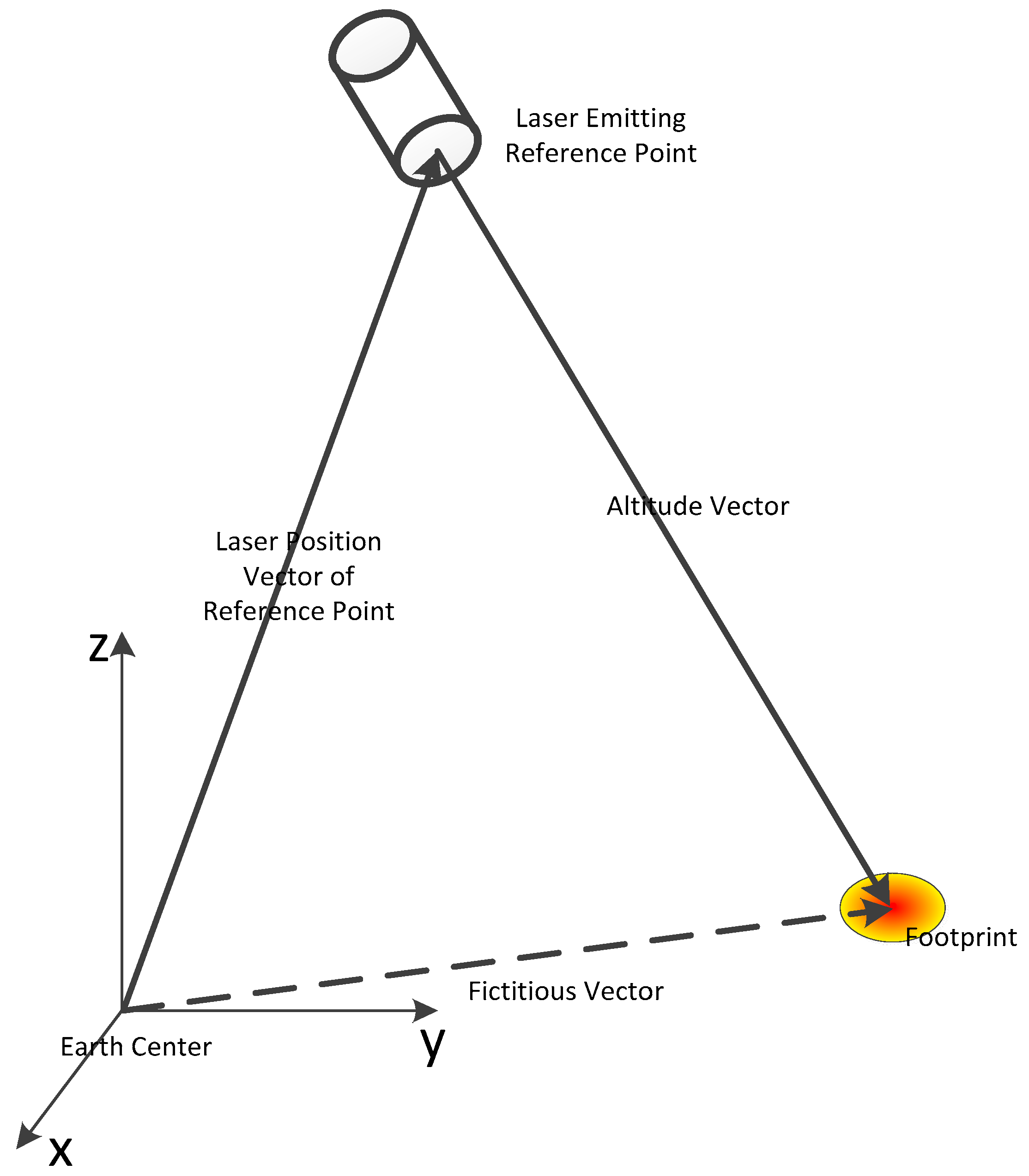
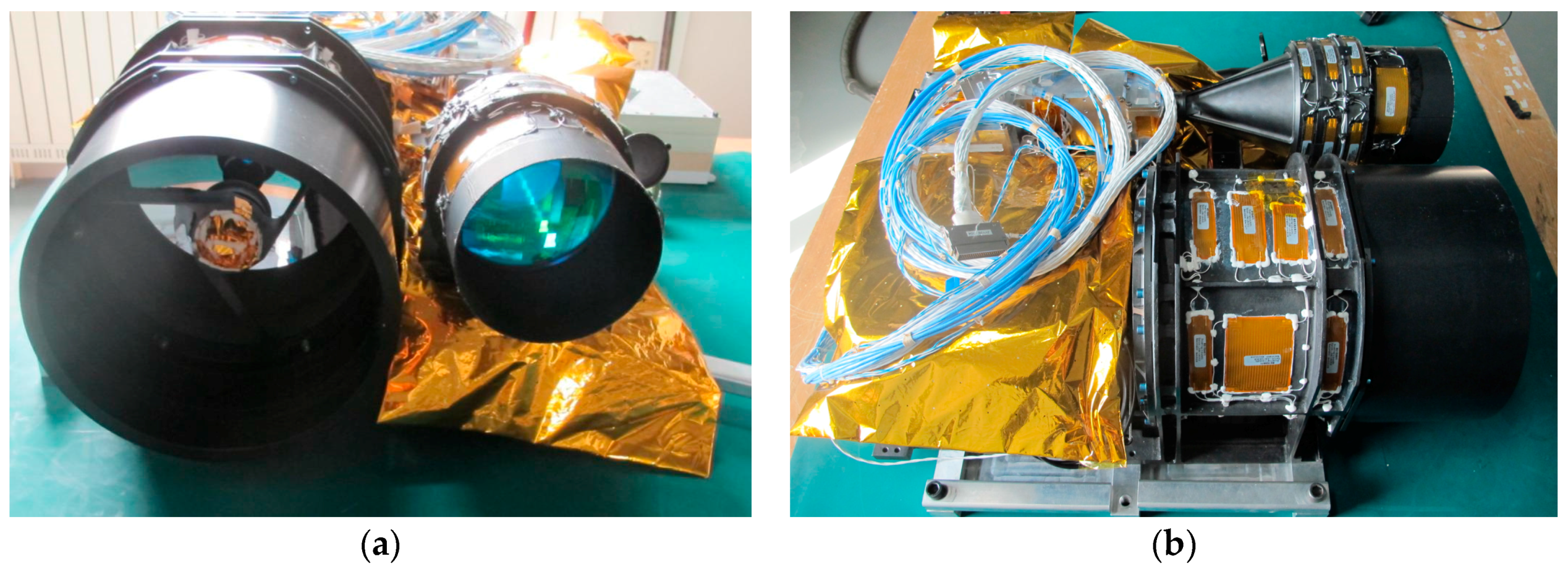
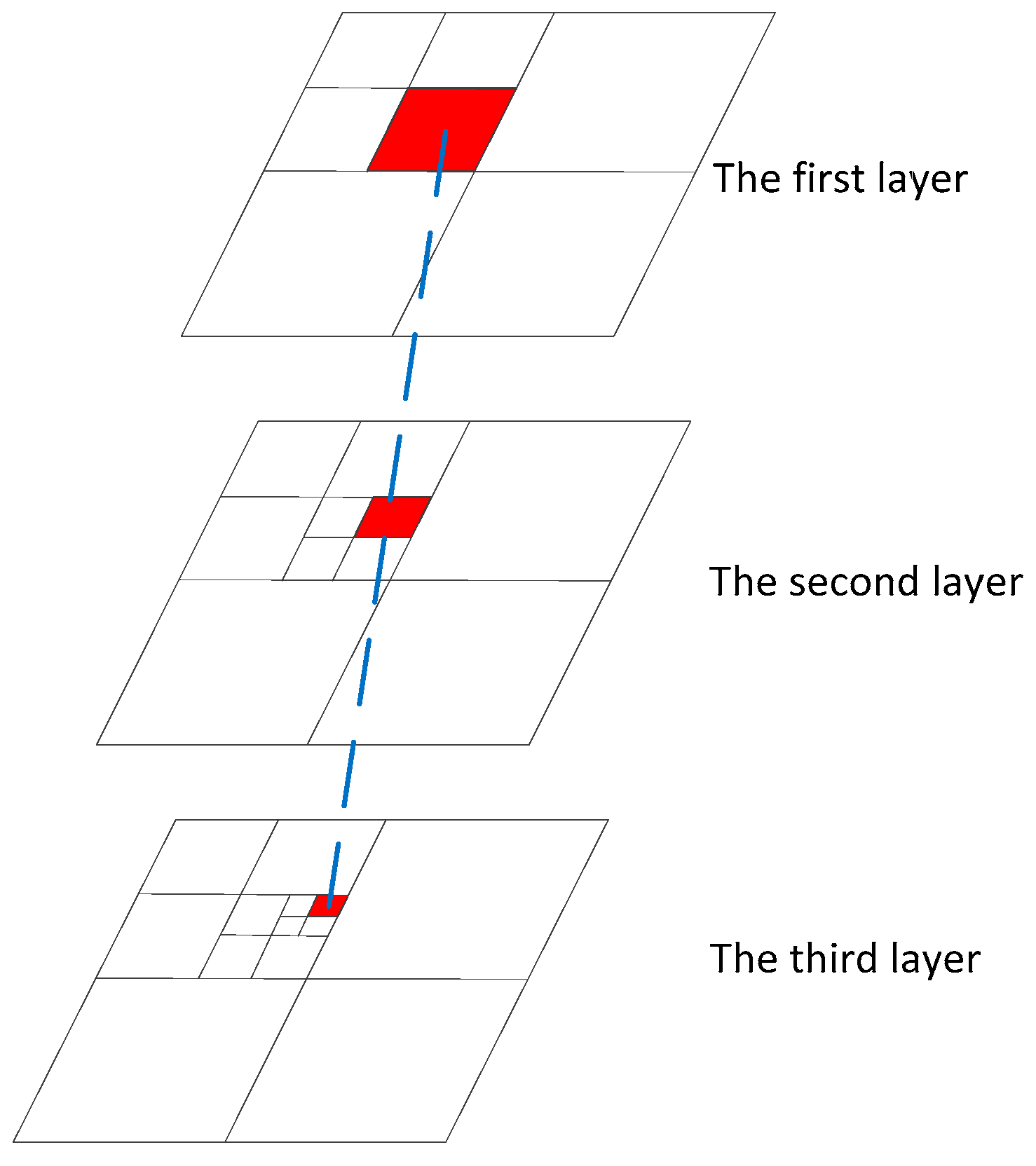

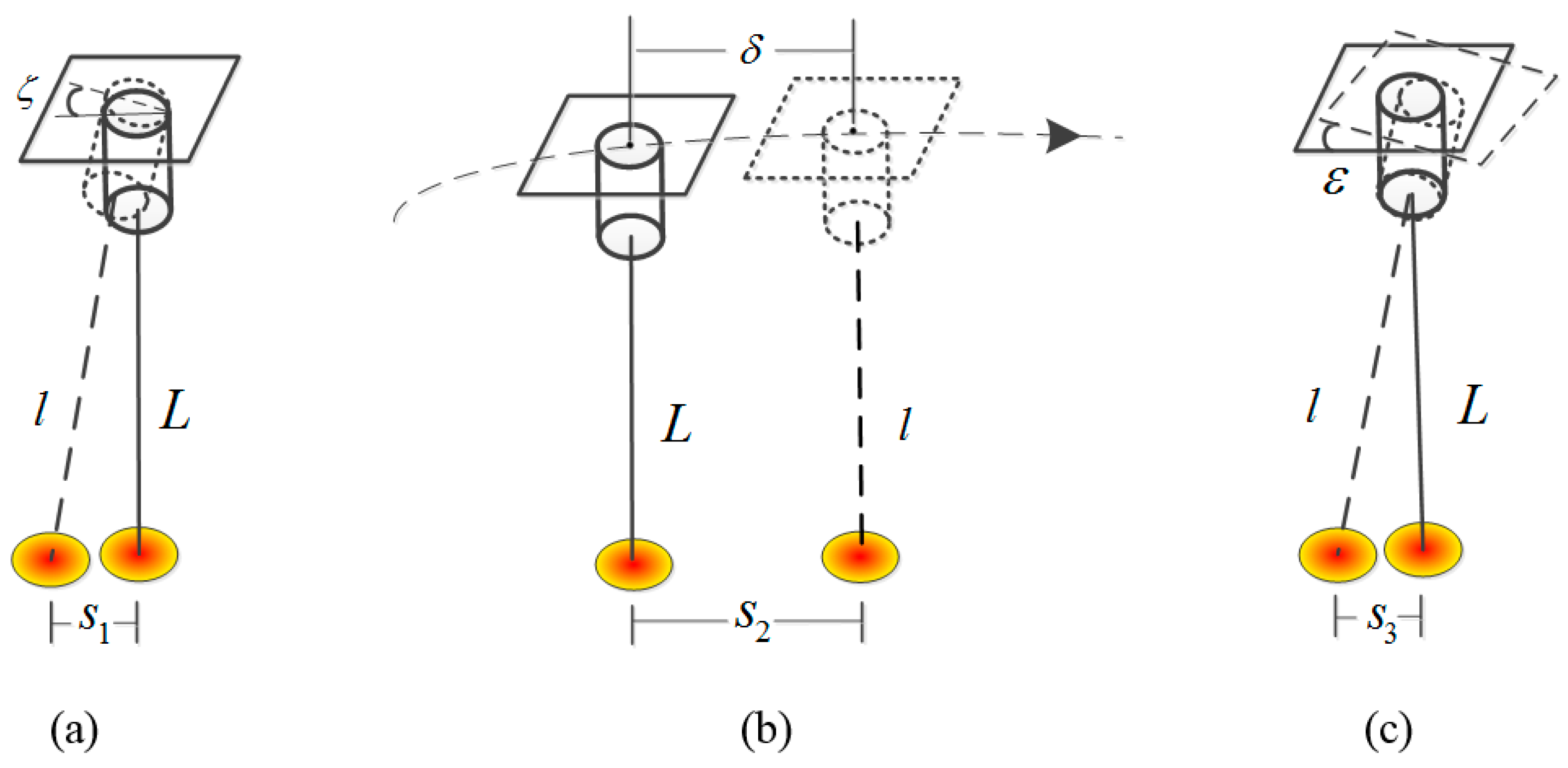

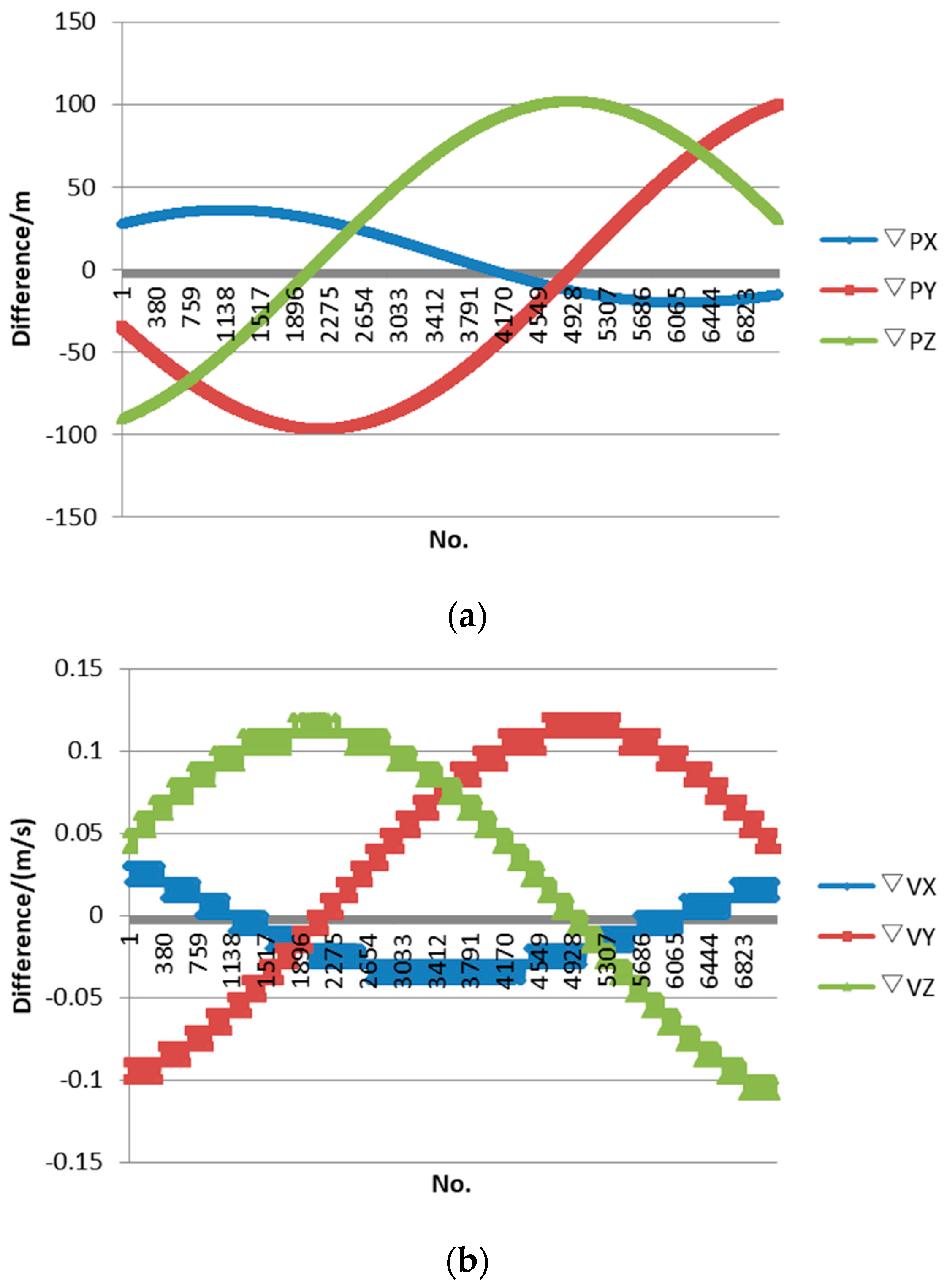
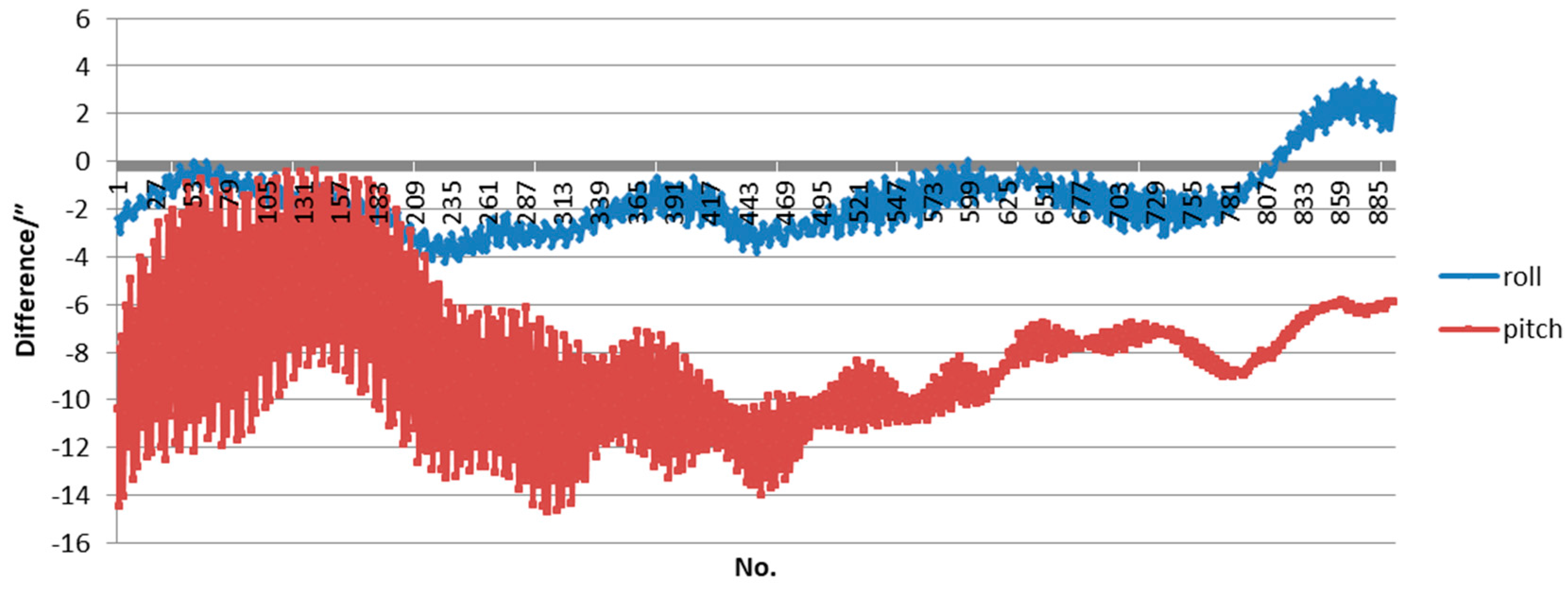


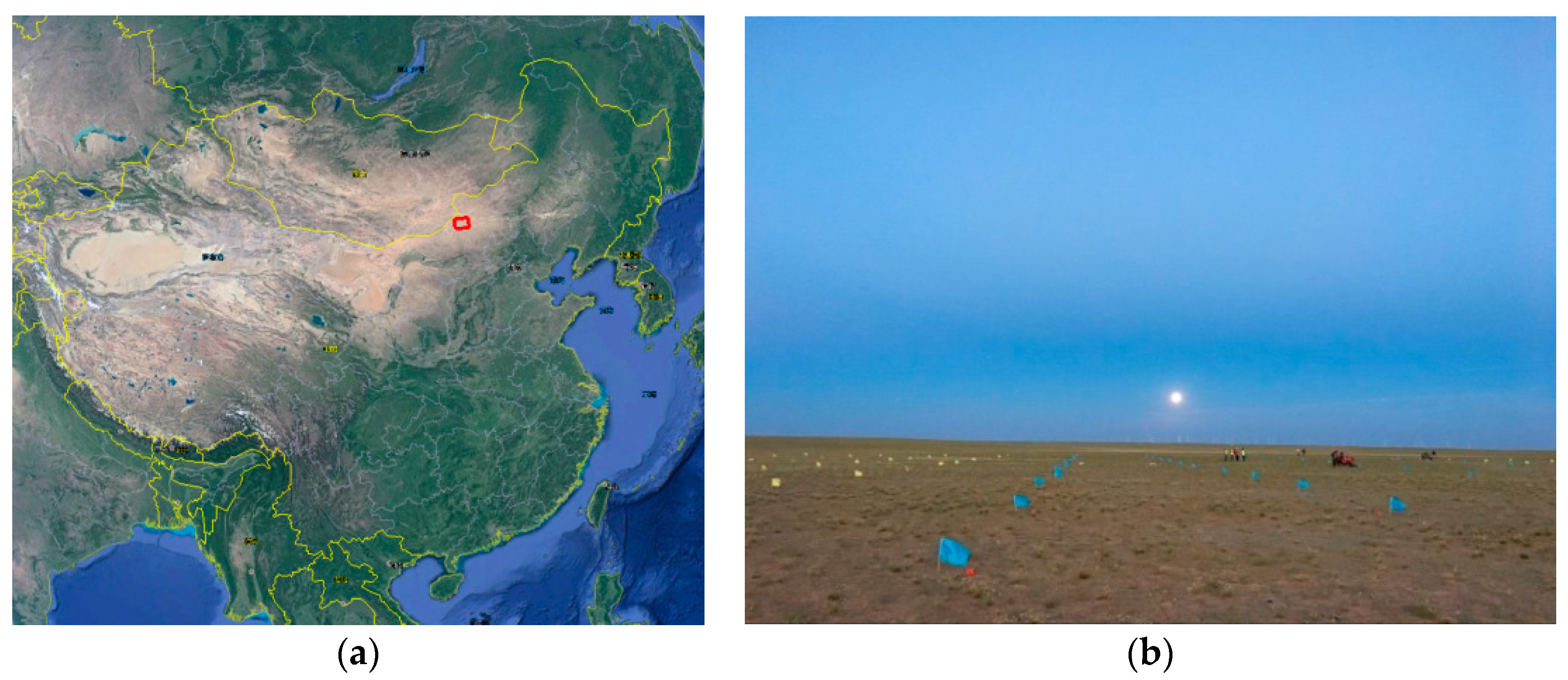
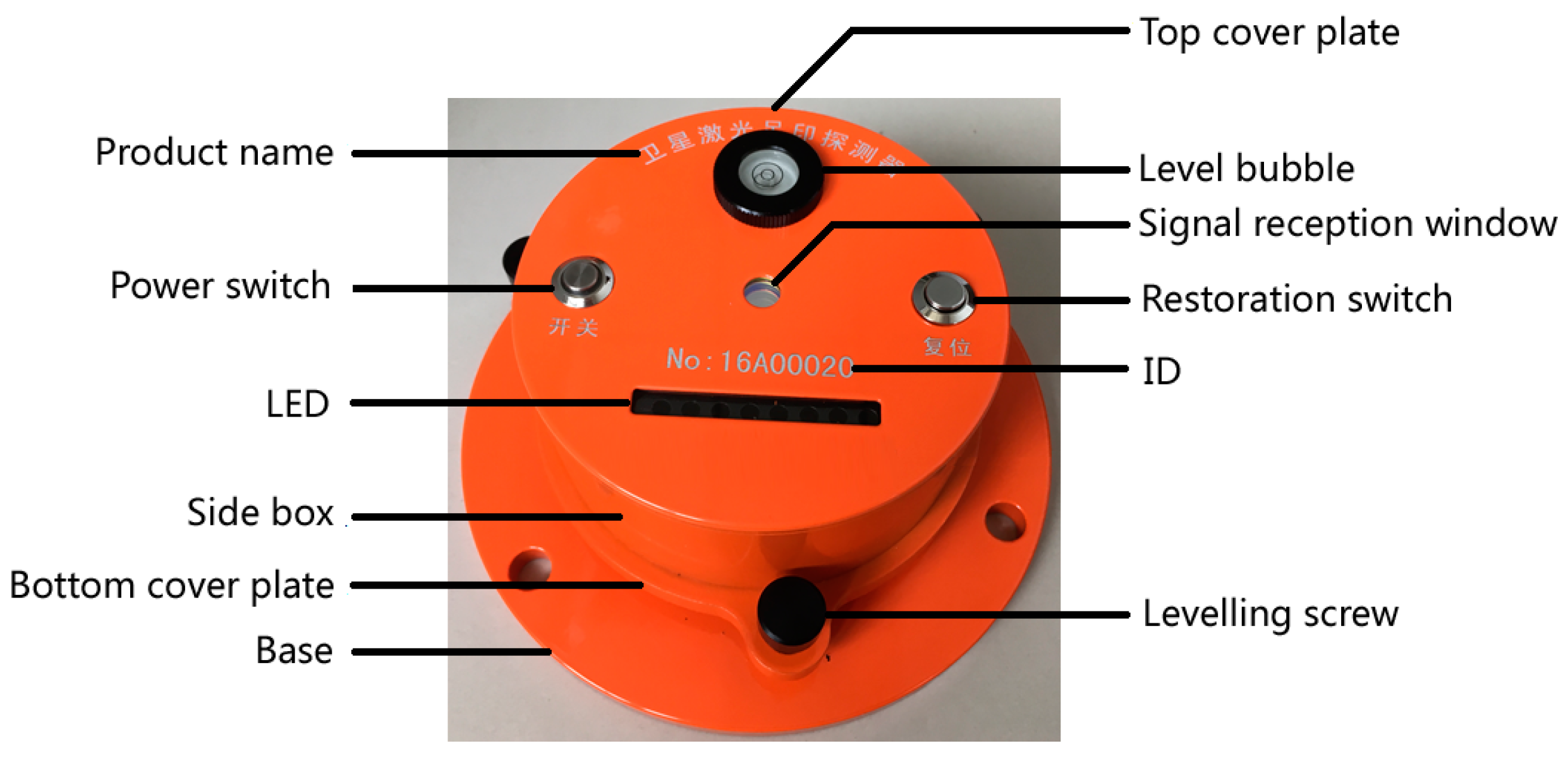


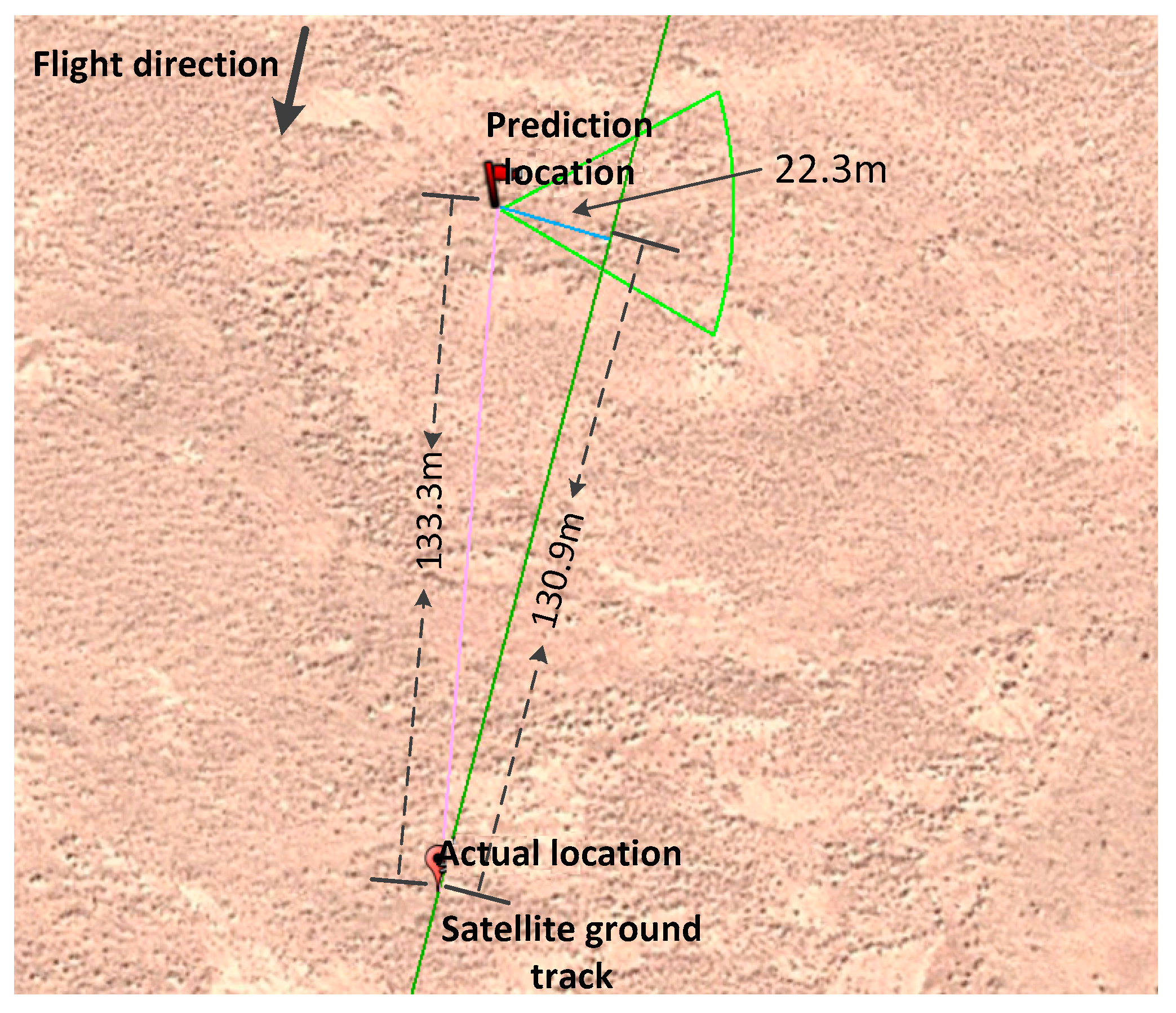

| Item | Value |
|---|---|
| Beam style | Single |
| Footprint size | 50 m 1 |
| Sample frequency | 2 Hz |
| Attitude stability | 5 × 10−4 °/s |
| Effective range | ≥520 km ± 20 km |
| Detection probability | ≥95% |
| Wavelength (Vacuum) | 1064 nm |
| Pulse width | <7 ns |
| Range accuracy | <1.0 m (gradient <15°) |
| Error | Along-Track/m | Cross-Track/m |
|---|---|---|
| Laser Pointing | 35 | 35 |
| Orbit | 150 | 20 |
| Attitude | 50 | 25 |
| Other | 10 | 10 |
| Total | 245 | 90 |
| Test time | The No. of Laser Point | Along track | Cross track | Horizontal | |||
|---|---|---|---|---|---|---|---|
| Average | RMSE | Average | RMSE | Average | RMSE | ||
| 9 August 2016 | 811 | 112.3 | 25.8 | 36.9 | 7.2 | 118.8 | 23.9 |
| 14 August 2016 | 903 | 131.2 | 21.3 | 15.5 | 9.6 | 132.5 | 21.1 |
| 19 August 2016 | 762 | 63.5 | 26.3 | 11.8 | 9.9 | 65.8 | 25.1 |
| 24 August 2016 | 718 | 39.5 | 26.0 | 14.6 | 7.5 | 43.6 | 24.9 |
| 29 August 2016 | 715 | 31.3 | 10.3 | 13 | 8.1 | 35.0 | 9.7 |
| Time | Weather | Arrangement | Deploy Distance | Spot Shape |
|---|---|---|---|---|
| Second 29, 11:29 a.m., 9 August 2016 | Excellent air quality, Spacing breeze 2–3 level, no clouds, high visibility. |  | 20 m |  |
| 40 m | ||||
| Seconds 5, 5.5, and 6, 11:28 a.m., 14 August 2016 | Excellent air quality, Spacing breeze 3 level, slight clouds, relatively high visibility. |  | 25 m |  |
 | ||||
 | ||||
| Second 36.5, 11:26 a.m., 19 August 2016 | Normal air quality, Spacing breeze 3 level, cloudy, ordinary visibility. |  | 20 m | Rainy, thick cloud which could not be penetrated by laser |
| Seconds 1.5 and 2t, 11:25 a.m., 24 August 2016 | Normal air quality, Spacing breeze 3 level, cloudy, ordinary visibility. |  | 20 m | Rainy, thick cloud which could not be penetrated by laser |
| Second 23.5, 11:23 a.m., 29 August 2016 | Excellent air quality, Spacing breeze 3 level, lightly cloudy, ordinary visibility |  | 10 m |  |
| Time | Error Direction | Ground Geolocation Error Caused by Each Error/m | ||||
|---|---|---|---|---|---|---|
| Pointing | Orbit | Attitude | Others | Overall | ||
| Second 29, 11:29 a.m., 9 August 2016 | Horizontal | 68.9 | 90.7 | 19.2 | 12.4 | 133.3 |
| Along-track | 43.8 | 90.4 | 7.4 | −10.7 | 130.9 | |
| Cross-track | 53.2 | −6.9 | −17.7 | −6.3 | 22.3 | |
| Second 5, 11:28 a.m., 14 August 2016 | Horizontal | 21.6 | 149.8 | 18.6 | 11.4 | 126.9 |
| Along-track | 18.0 | −149.4 | 8.2 | 5.7 | −117.5 | |
| Cross-track | 11.9 | 7.1 | 16.7 | 2.9 | 38.6 | |
| Second 23.5, 11:23 a.m., 29 August 2016 | Horizontal | 2.6 | 27.3 | 20.4 | 19.0 | 43.5 |
| Along-track | 1.8 | −27.2 | 3.5 | 0.8 | −21.1 | |
| Cross-track | 1.9 | 0.9 | 20.1 | 15.2 | 38.1 | |
© 2017 by the authors. Licensee MDPI, Basel, Switzerland. This article is an open access article distributed under the terms and conditions of the Creative Commons Attribution (CC BY) license (http://creativecommons.org/licenses/by/4.0/).
Share and Cite
Xie, J.; Tang, X.; Mo, F.; Li, G.; Zhu, G.; Wang, Z.; Fu, X.; Gao, X.; Dou, X. ZY3-02 Laser Altimeter Footprint Geolocation Prediction. Sensors 2017, 17, 2165. https://doi.org/10.3390/s17102165
Xie J, Tang X, Mo F, Li G, Zhu G, Wang Z, Fu X, Gao X, Dou X. ZY3-02 Laser Altimeter Footprint Geolocation Prediction. Sensors. 2017; 17(10):2165. https://doi.org/10.3390/s17102165
Chicago/Turabian StyleXie, Junfeng, Xinming Tang, Fan Mo, Guoyuan Li, Guangbin Zhu, Zhenming Wang, Xingke Fu, Xiaoming Gao, and Xianhui Dou. 2017. "ZY3-02 Laser Altimeter Footprint Geolocation Prediction" Sensors 17, no. 10: 2165. https://doi.org/10.3390/s17102165




